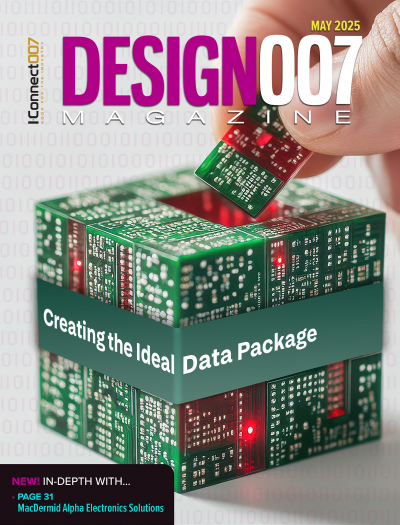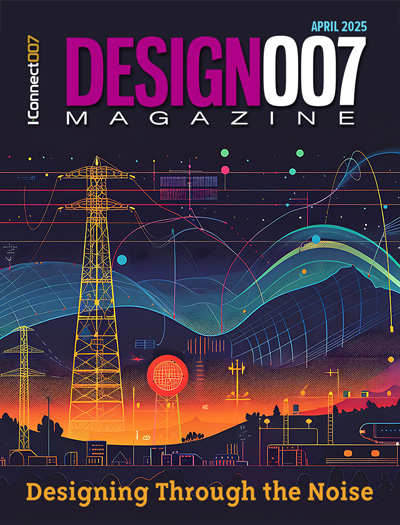-

- News
- Books
Featured Books
- design007 Magazine
Latest Issues
Current Issue
All About That Route
Most designers favor manual routing, but today's interactive autorouters may be changing designers' minds by allowing users more direct control. In this issue, our expert contributors discuss a variety of manual and autorouting strategies.

Creating the Ideal Data Package
Why is it so difficult to create the ideal data package? Many of these simple errors can be alleviated by paying attention to detail—and knowing what issues to look out for. So, this month, our experts weigh in on the best practices for creating the ideal design data package for your design.

Designing Through the Noise
Our experts discuss the constantly evolving world of RF design, including the many tradeoffs, material considerations, and design tips and techniques that designers and design engineers need to know to succeed in this high-frequency realm.
- Articles
- Columns
- Links
- Media kit
||| MENU - design007 Magazine
Mentor’s EDA Perspective on Managing Design Rules
May 30, 2019 | Andy Shaughnessy, Design007 MagazineEstimated reading time: 3 minutes
I recently spoke with Dave Wiens, product manager, and Mike Santarini, EDA content director of corporate marketing, both of Mentor, a Siemens business, about design rules and constraints, and what their customers want regarding design rules. They explained how EDA companies like Mentor help designers constrain for performance while avoiding over-constraining and increasing the cost of the board and also being manufacturing-aware.
Andy Shaughnessy: Can you start by telling us about what your customers want in their design rules capabilities. What do you try to provide them as far as design rules?
Dave Wiens: Customers have to take all of the design constraints and manage what might be conflicts between those and determine what the tradeoffs are to optimize the product. From a tool perspective, we try to enable whoever is defining those constraints to do it as easily as possible within a common environment, and then pass those on to whoever is going to utilize them. Often, it’s the layout designer that has to implement the constraints. They’re dealing with the physical embodiment of the product, but there are constraints on the schematic stage as well. We help them automate the definition of those constraints, simplify the entry, but it’s not enough to define constraints. You also have to validate those constraints.
You must try to simplify the way it’s done so that somebody can look at a design and say that it passed. It’s about simplifying constraint definition as well as adherence to the constraints and verification. So, how does the designer do the design and try to adhere to constraints? Ensure that the full design verification and constraints were met and that the product is going to work. Again, the problem is constraints are coming from multiple people, for instance different requirements on performance might being at odds with each other.
Shaughnessy: One of the designers I talked to said that the problem is that no one person can remember all of these things simultaneously.
Wiens: Right. And in the old “Wild West” of design, there wasn’t a constraint editor. Then, you got constraints and had an engineer talking over your shoulder, saying, “When you route these two traces, keep them this far apart.” It was all digitized, and you had to use old-fashioned ways to determine whether they were far enough apart. There was no such thing as a digital constraint or something to adhere to.
The idea of becoming aware of all of them is a big thing, so from an EDA perspective, we try to automate these things. We help gather all of those constraints in one place. There are still things that can be done to improve on that. It’s about having a streamlined way so that you can pass constraints from whoever defined them. If it came from the engineer at the front or the manufacturing NPI engineer at the back, the process helps define those and pass them to the person who has to implement them.
Shaughnessy: Many designers say they don’t even know who is going to be fabricating their board or prototype, much less production. How do you figure all of that in the design rules? Do you have to re-enter it each time?
Wiens: In most tools you do. Not just every job, but you want to be able to design for multiple manufacturers, for instance. And you definitely want to be able to retarget, and that’s one of the things that we’ve been able to do thanks to our Valor technology. The majority of manufacturers out there, around 80%, use Valor for their verification tool. If they’re using Valor, they can pass the designer those rule decks. Then, the designer can retarget without having to reenter a bunch of constraints. They can say, “I want to go after this manufacturer instead of this one,” and do it with a rule deck that the majority of manufacturers use.
To read this entire interview, which appeared in the May 2019 issue of Design007 Magazine, click here.
Suggested Items
Facing the Future: Time for Real Talk, Early and Often, Between Design and Fabrication
07/08/2025 | Prashant Patel -- Column: Facing the FutureThere has always been a subtle but significant divide between those who design and those who build printed circuit boards. It’s not a hostile gap, but it is a real one, and in today’s high-speed, high-complexity, high-stakes environment, that gap is costing us more than time and yield. It’s costing us innovation.
DownStream Acquisition Fits Siemens’ ‘Left-Shift’ Model
06/26/2025 | Andy Shaughnessy, I-Connect007I recently spoke to DownStream Technologies founder Joe Clark about the company’s acquisition by Siemens. We were later joined by A.J. Incorvaia, Siemens’ senior VP of electronic board systems. Joe discussed how he, Rick Almeida, and Ken Tepper launched the company in the months after 9/11 and how the acquisition came about. A.J. provides some background on the acquisition and explains why the companies’ tools are complementary.
Elementary Mr. Watson: Retro Routers vs. Modern Boards—The Silent Struggle on Your Screen
06/26/2025 | John Watson -- Column: Elementary, Mr. WatsonThere's a story about a young woman preparing a holiday ham. Before putting it in the pan, she cuts off the ends. When asked why, she shrugs and says, "That's how my mom always did it." She asks her mother, who gives the same answer. Eventually, the question reaches Grandma, who laughs and says, "Oh, I only cut the ends off because my pan was too small." This story is a powerful analogy for how many PCB designers approach routing today.
Connect the Dots: The Future of PCB Design and Manufacturing
07/02/2025 | Matt Stevenson -- Column: Connect the DotsFor some time, I have been discussing the increasing complexity of PCBs and how designers can address the constantly evolving design requirements associated with them. My book, "The Printed Circuit Designer’s Guide to… Designing for Reality," details best practices for creating manufacturable boards in a modern production environment.
Siemens Turbocharges Semiconductor and PCB Design Portfolio with Generative and Agentic AI
06/24/2025 | SiemensAt the 2025 Design Automation Conference, Siemens Digital Industries Software today unveiled its AI-enhanced toolset for the EDA design flow.


